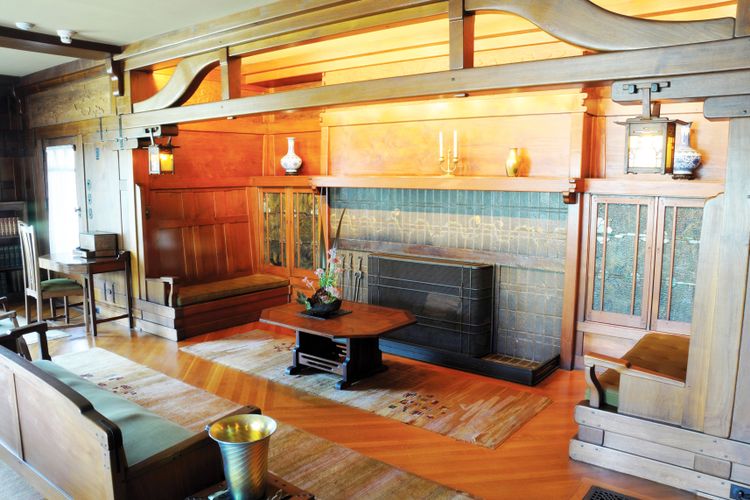ART WORLD NEWS
The Arts and Crafts special relationship: how the British movement permeated US design culture
[ad_1]
An exemplary Arts and Crafts interior by Greene & Greene: the living room of Gamble House, Pasadena, California (1908-09)
Courtesy Gamble House / Eye Ubiquitous / Alamy
The Rise of Everyday Design: The Arts and Crafts Movement in Britain and America is a companion book, as well as a stand-alone volume, to an exhibition at the University of Texas at Austin (until 14 July). Its introduction and 12 chapters, with more than 200 illustrations, are the work of nine US scholars including the exhibition curators and book’s editors, Monica Penick and Christopher Long. It serves as both an introductory text and, for those well-read on the movement, one offering new dimensions to this vast subject.
Major emphasis is given to the evolution of the movement’s ideals and their dissemination through books, magazines, catalogues, pattern books, plan books, advertisements, exhibitions and other means. The extensive coverage of the roles of many publications in defining and spreading Arts and Crafts principles and products, such as Ladies’ Home Journal and House Beautiful in the US, is one of its contributions to Arts and Crafts literature. Treated as well is the design of publications, including a single chapter devoted to Morris’s Kelmscott Press, another to influences on books in the US.
Good-quality design of one’s environment was believed to have improved social and moral consequences
The introduction and first four chapters lay out the foundation for the Arts and Crafts philosophy, especially as articulated by John Ruskin and William Morris in Britain, whose writings found audiences on both sides of the Atlantic. Much of this material is well known but supports the subsequent chapters. These ideals rejected industrialisation in favour of handcrafting, honesty of materials, and design integrity and usefulness. The reaction was to the way objects were mass produced in factories, with sacrifices in quality and design, and the impact industrialisation had on people’s lives. Good-quality design of one’s environment was believed to have improved social and moral consequences. The challenge was how individually designed and handcrafted works could be made available to a broad audience at affordable prices.
In several chapters the point is made that the British designers were less likely than the Americans to compromise ideals whereas the democratisation of the style happened more readily in the US through the embrace of machine production and lenient copyright laws. One insightful chapter is devoted to how original design received greater protection in the UK than in the US—where manufacturers could market factory-produced variations or knock-offs of designs by makers such as Roycroft or Gustav Stickley. This point is followed up with new research on Come-Packt furniture, shipped unassembled, and its direct sales through catalogue marketing, thus making it inexpensive.
With the focus clearly on the ideas and how they were promulgated, the aesthetics and specific designs of the objects themselves are given less attention, and there is very little mention of the potteries that were so important to the movement, including the artistic and employment opportunities offered for women. Instead, another strength of the book is the attention to residential architecture, with the last three chapters devoted to the design of US homes by various architects. Some are well known (Wright, Greene & Greene), others less so (Leila Ross Wilburn, Harwell Hamilton Harris). Sears & Roebuck’s catalogue offerings of manufactured houses was an economic alternative covered in one chapter. The movement was indeed a transformation of lifestyle.
The movement waned in the second decade of the 20th century. Interest was revived in the 1970s, evidenced and spurred by the Princeton University exhibition in 1972 The Arts and Crafts Movement in America 1876-1916. Perhaps The Rise of Everyday Design and its excellent publication indicates a new surge of interest. As Penick states in the final chapter: “The Arts and Crafts movement may have lost momentum by the time the United States entered the First World War… but interest in Arts and Crafts ideals persisted particularly in their ‘democratised’ and popularised forms. In fact, these ideas permeated American design culture well after the Second World War—into the 1950s, and, in some form, into the present day.”
Roger Dunn was professor of Art History at Bridgewater State University, Massachusetts. He was a contributor to Stitching Resistance: Women, Creativity, and Fiber Arts (2014)
- Monica Penick and Christopher Long, eds. The Rise of Everyday Design: the Arts and Crafts Movement in Britain and America, Yale University Press, 256pp, £45 (hb)
[ad_2]
Source link













